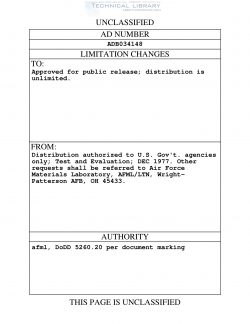AFML-TR-78-103-V1
- Version
- 234 Downloads
- 5.73 MB File Size
- 1 File Count
- March 1, 2017 Create Date
- March 1, 2017 Last Updated
Manufacturing Methods for Cutting, Machining and Drilling Composites - Vol I; Composites Machining Handbook

Conventional cutting methods were compared to new technology methods Such as water—jet, laser and reciprocating cutting. Although the high—speed and reciprocat— ing cutters worked well with some uncured materials, the slower laser cutter was able to handle all of the materials studied. Steel—rule die blanking was found to be well suited for cutting multiple plies of uncured materials. Wtth regard to cured materials, the water—jet could effectively cut graphite/epoxy, Kevlar/epoxy and fiberglass/epoxy, while the low— power (250 watts) laser could effectively cut only Kevla r/epoxy. The feasibility of produc— ing preplaced holes by blanking was demonstrated and verified by tensile tests. Several, new low—cost techniques were established for drilling of graphite/epoxy and hybrids thereof. High—speed (21, 000 rpm) drilling of graphite/epoxy doubled the life of solid carbide tools. The use of ultrasonic adapters on portable drilling units increased drill life by 100 percent with graphite—boron/epoxy hybrids. Tool geometries that can be successfully applied to Kevla r/ epoxy were established. New cutting tool designs for in— serted—compacted diamond tools Were generated. Operating parameters were established for routing, trimming, beveling, counter— sinking and counterboring. In general, diamond—cut carbide router bits were effective for routing and trimming graphite/epoxy and fiberglass/epoxy. Diamond—chip and opposed— helix router bits had to be used to cut boron/epoxy and Kevla r/epoxy, respectively. Modification of the countersink relief and rake angles substantially improved tool life (from 50 to 300 holes) (when drilling graphite/ epoxy. ) A comprehensive review of all available NDE techniques that could be applied to the inspection of cut, drilled and machined composites was made. The most effective technique that could reliably be applied in a low—cost pmduction mode was tracer fluoroscopy. A prototype, automated inspection system was developed and evaluated under simulated production conditions to facilitate integration of the system with the manufacturing process. Projected time savings for the approach compared to that for manual techniques exceeded 80 percent.
| File | Action |
|---|---|
| AFML-TR-78-103-V1 Manufacturing Methods for Cutting, Machining and Drilling Composites - Vol I; Composites Machining Handbook.pdf | Download |

Comment On This Post